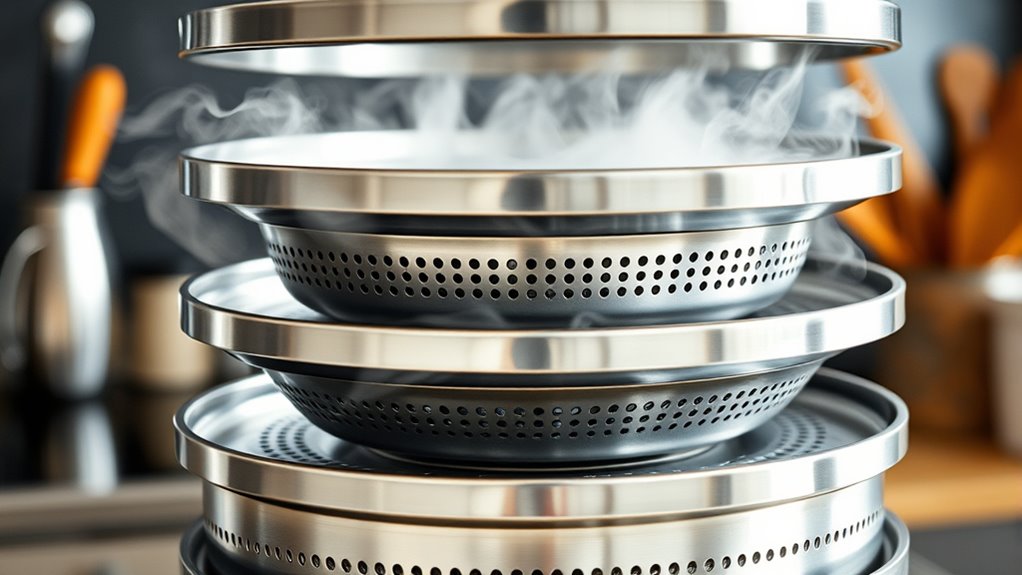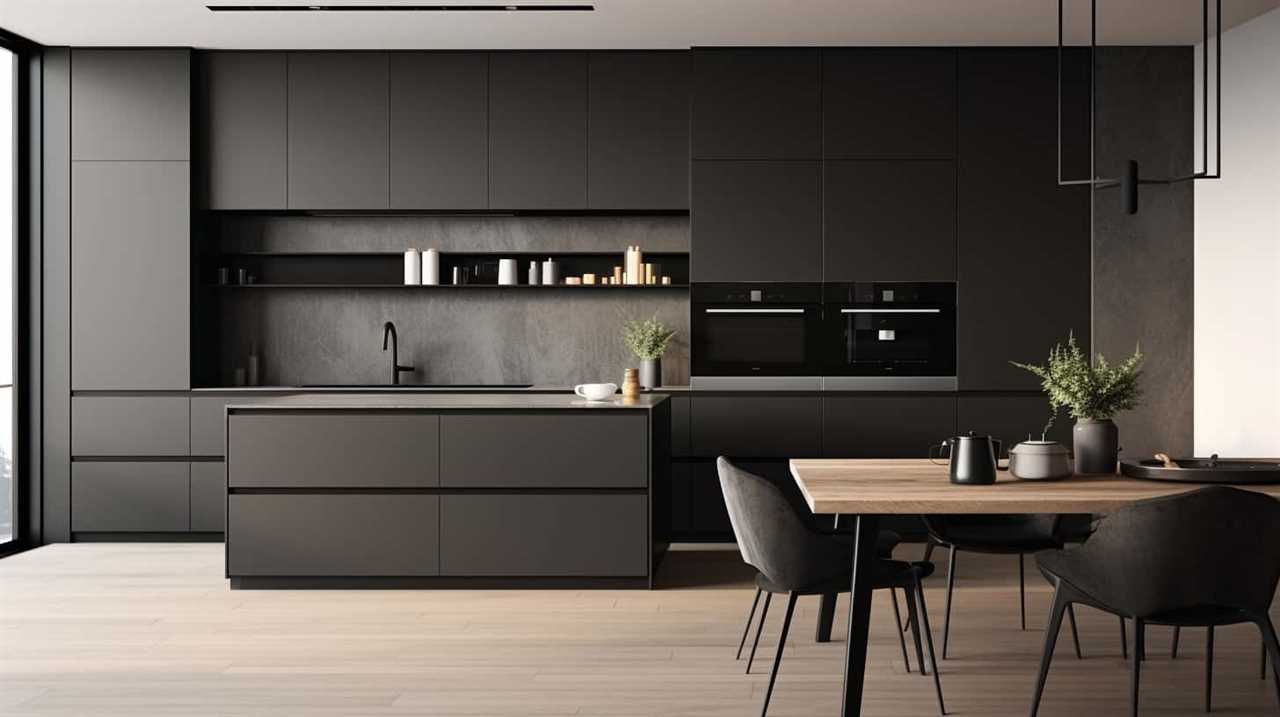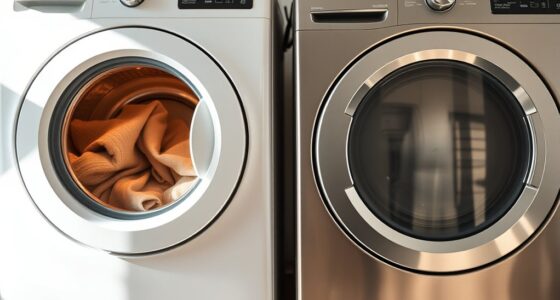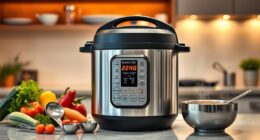Countertop food steamers distribute steam through internal circulation systems, ensuring even heat and moisture. They generate steam via boiler-based or boilerless methods, with fans and diffuser plates spreading the moisture uniformly. Pressurized steam flows rapidly over food, speeding cooking and maintaining consistent temperature and humidity. Proper design features and controls help optimize steam flow, which is key to improving food quality and efficiency. Keep exploring to understand how these systems work together for perfect results.
Key Takeaways
- Internal circulation fans evenly distribute steam, preventing hot or cold spots for uniform cooking.
- Diffuser plates and chamber design promote consistent steam flow over all food surfaces.
- Pressurized steam ensures even heat distribution by enveloping food items uniformly.
- Rapid steam penetration speeds up heat transfer, maintaining moisture and food quality.
- Proper maintenance of steam systems sustains optimal distribution and consistent performance.
Types of Steam Generation in Countertop Food Steamers
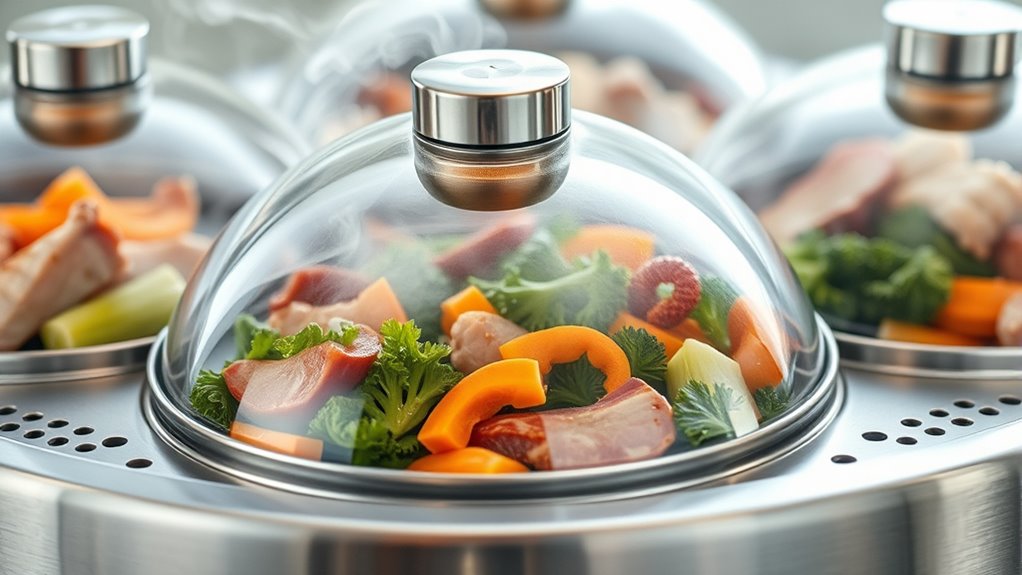
Countertop food steamers generate steam through two main methods: boiler-based and boilerless systems. With boiler-based models, a separate steam generator or boiler produces pressurized steam that’s evenly distributed into the cooking chamber. This setup often requires professional installation of water lines and drainage but offers a steady steam supply, making it ideal for high-volume kitchens. In contrast, boilerless steamers generate steam internally from a water reservoir inside the unit. They use either a sprayer that quickly converts water into steam or an open boiling water reservoir. These units are more flexible in placement since they don’t need plumbing connections but require manual water refilling and are more vulnerable to damage if run dry. Both types serve different needs depending on your kitchen’s volume and infrastructure. Understanding the differences helps operators select the most suitable steamer for their specific operational requirements, especially considering the types of steam generation that best fit their setup. Additionally, the maintenance requirements for each system vary, influencing long-term operational costs.
How Pressurized Steam Ensures Even Cooking
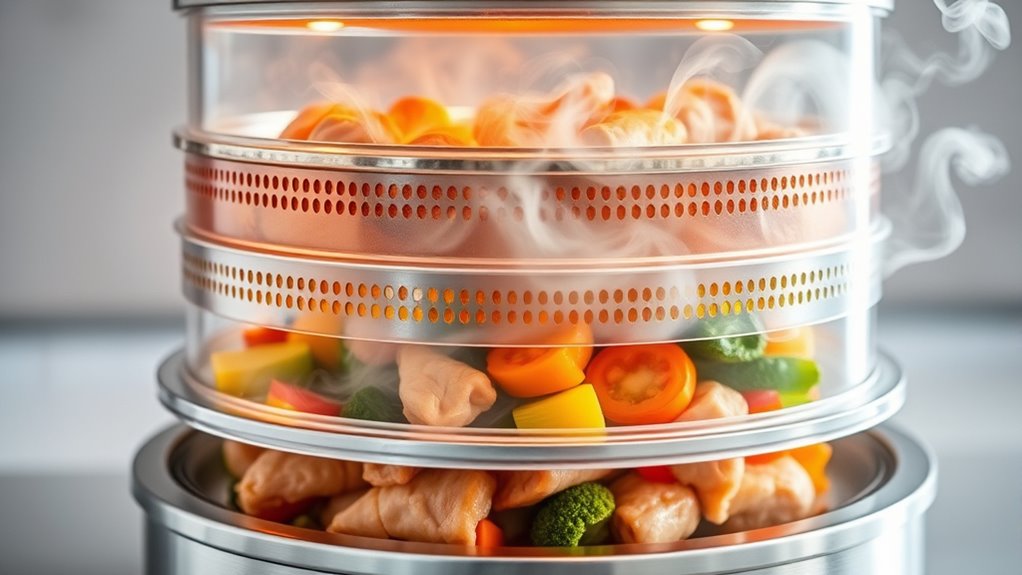
Pressurized steam helps you cook food evenly by forcing hot steam to circulate uniformly throughout the chamber. This rapid moisture penetration guarantees each part of your dish heats consistently, preventing cold spots. Larger models support full or fractional hotel pans, which can facilitate better steam distribution. Additionally, the mechanics of pinball machines can influence how effectively heat and pressure are maintained within the steamer, ensuring optimal cooking conditions. With precise temperature control, your meals stay flavorful and cooked to perfection every time.
Uniform Heat Distribution
Pressurized steam plays an essential role in achieving uniform heat distribution within food steamers by rapidly circulating and evenly enveloping your food items. This circulation ensures consistent temperature and moisture levels throughout the chamber. The latent heat carried by steam transfers energy efficiently, touching all surfaces in contact. The high thermal capacity maintains steady temperatures, even with door openings or load changes. A sealed environment prevents stratification and cold spots by promoting continuous steam movement. Additionally, the sealed environment minimizes heat loss and maintains pressure, further enhancing even cooking. Proper maintenance of the steam system is also crucial to sustain optimal distribution and performance.
Rapid Moisture Penetration
Have you ever wondered how steam can penetrate food so quickly and evenly during cooking? It all comes down to pressurized steam’s properties. High-energy water vapor condenses on cooler food surfaces, releasing latent heat that transfers rapidly and efficiently. Because the steam is under pressure, it reaches higher temperatures, increasing the energy transfer rate and speeding up moisture absorption. This high temperature and pressure gradient allow steam to infiltrate pores and cellular structures swiftly, ensuring even internal cooking. As steam condenses, it deposits moisture directly into the food, preserving juiciness and aiding in processes like starch gelatinization and protein denaturation. Continuous, well-distributed steam flow prevents dry spots and encourages uniform moisture penetration, resulting in evenly cooked, flavorful dishes with ideal texture.
Consistent Temperature Control
Maintaining a consistent temperature is essential for achieving evenly cooked food in countertop steamers, and pressurized steam systems excel at this task. They create a stable environment where heat is evenly distributed, ensuring uniform cooking. Here’s how pressurized systems support this:
- They achieve higher temperatures quickly, reducing hot spots.
- The pressurized environment maintains constant heat levels.
- Advanced sensors monitor temperature for precision control.
- The system’s design minimizes fluctuations, preventing cold or overcooked spots.
- Ongoing AI safety measures help ensure that automated control systems operate reliably and securely.
- Implementing temperature regulation techniques further enhances the consistency of heat distribution.
This reliable control helps keep food at safe temperatures above 141°F, preventing bacteria growth. While pressurized systems are less flexible, their ability to deliver uniform heat makes them ideal for consistent results, especially in busy commercial settings.
The Role of High-Pressure Jets in Rapid Food Preparation
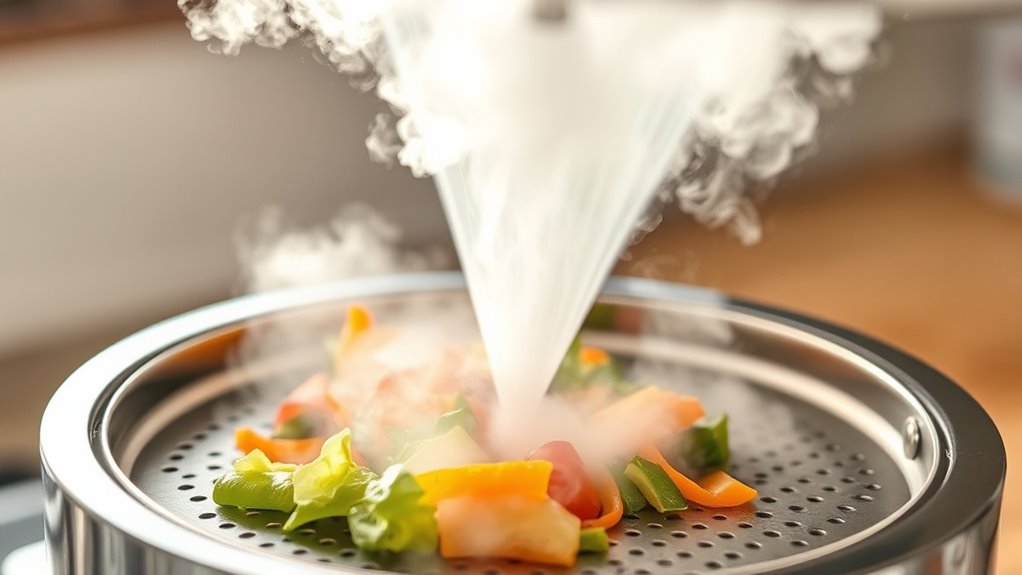
High-pressure jets in countertop steamers deliver heat quickly, cutting down cooking times substantially. They also guarantee moisture is evenly distributed, preventing dry spots and overcooking. This technology helps you prepare food faster while maintaining consistent quality. Additionally, high refresh rates can improve overall cooking efficiency by allowing rapid heat transfer. Implementing steam distribution techniques ensures the heat reaches all areas uniformly, further enhancing cooking performance.
Fast Heat Penetration
High-pressure jet technology revolutionizes food preparation by markedly accelerating heat transfer during steaming. These jets eject high-temperature steam through small nozzles, creating a powerful effect that boosts cooking speed. Imagine:
- Steam being directed directly onto food surfaces, increasing conduction efficiency.
- Elevated steam temperatures (up to ~250°F) due to pressure, speeding heat absorption.
- Rapid, uniform cooking enabled by the velocity of jets penetrating thick items.
- Multiple levels of baskets ensuring even steam distribution and quick heat transfer.
- The reliability of high-pressure systems ensures consistent performance and safety during operation.
This system maintains moisture and nutrients while reducing cooking times by up to 50%. The continuous steam supply sustains high jet velocity, ensuring consistent heat penetration. Overall, high-pressure jets dramatically cut down cooking duration without sacrificing quality.
Even Moisture Distribution
The efficiency of rapid food preparation with countertop steamers hinges on how evenly moisture is distributed throughout the cooking chamber. High-pressure jets play a vital role by dispersing steam uniformly over your food surfaces, preventing dry spots and ensuring consistent cooking. These jets create a puffing effect, enveloping ingredients quickly and maintaining a sealed environment that preserves moisture. Because the jets operate within a sealed chamber, they avoid steam pockets, saturating the entire volume evenly. This consistent moisture retention helps preserve your food’s original texture, color, and flavor while minimizing condensation that can make food soggy. The rapid, high-pressure steam also supports simultaneous cooking of different food types, ensuring each item receives even moisture for excellent results.
Internal Steam Circulation for Temperature and Moisture Control
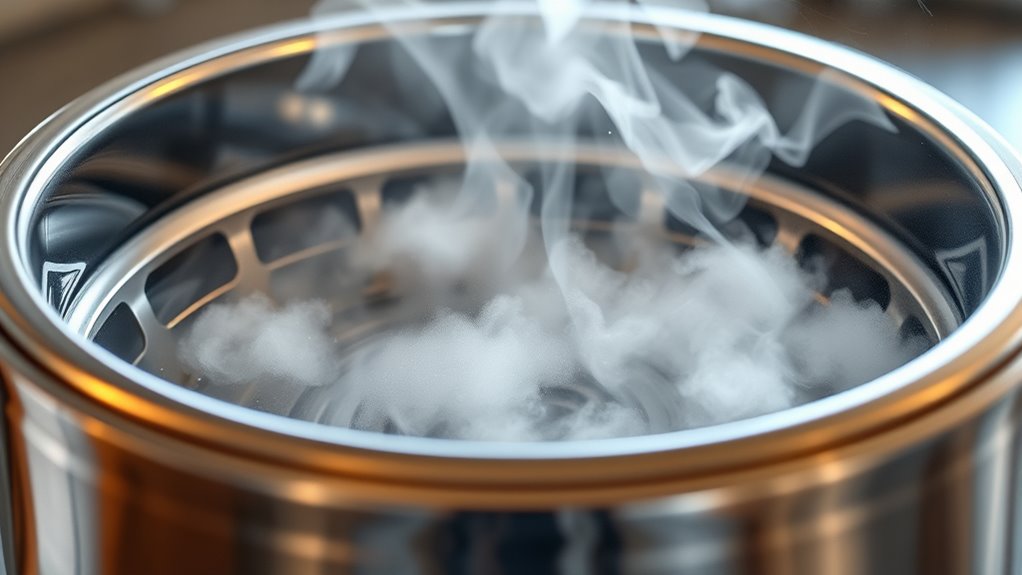
Internal steam circulation plays a vital role in maintaining consistent temperature and moisture levels within countertop steamers. You’ll notice that many models use fans to distribute steam evenly inside the cabinet, preventing hot spots and uneven cooking. Some units generate steam directly with open reservoirs or spritzers, ensuring a steady supply. Convection technology circulates steam at 212°F, promoting uniform heat. To paint a clearer picture:
Internal circulation ensures even cooking and moisture retention in countertop steamers.
- Fans evenly spread steam throughout the interior.
- Convection tech maintains consistent temperature at boiling point.
- Reservoir or spritzers generate steady steam inside the unit.
- Circulation systems optimize cooking efficiency and prevent moisture imbalances.
This internal circulation keeps your food moist, evenly cooked, and at the right temperature, all while reducing cooking time. Additionally, steam distribution systems help prevent condensation buildup, preserving food quality and ensuring efficient operation. Proper steam flow management is essential for achieving optimal cooking results and maintaining energy efficiency in countertop food steamers.
Design Features That Influence Steam Distribution
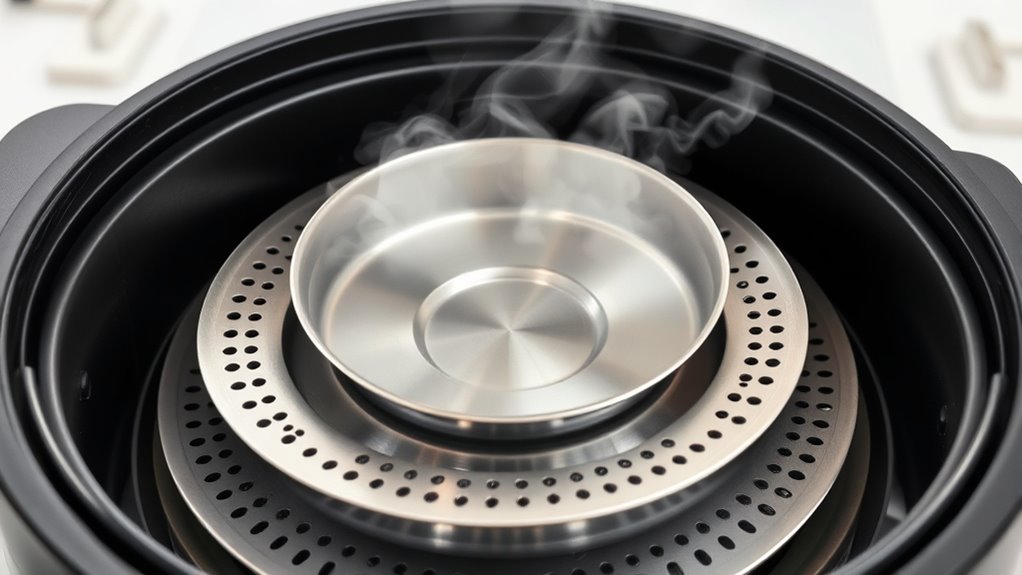
Design features like steam diffuser plates, pan supports, and door seals play a crucial role in guaranteeing even steam distribution within countertop food steamers. Diffuser plates spread steam uniformly over pans, preventing hot or cold spots, while removable stainless steel supports ensure consistent exposure of food to steam. The chamber’s material, like 316 stainless steel with coved corners, promotes better circulation, and welded chambers eliminate flow disruptions. Doors with positive lock-and-seal mechanisms maintain pressure, and insulated doors reduce heat loss, stabilizing internal conditions. Larger chambers or multiple pans require tailored diffusion paths to guarantee uniform cooking. Additionally, steam flow dynamics significantly influence how effectively heat and moisture are distributed throughout the chamber, and understanding these steam distribution principles can lead to improved performance and energy efficiency.
Operational Controls for Optimizing Steam Delivery

Operational controls are essential for fine-tuning steam delivery and ensuring ideal cooking results in countertop food steamers. These controls allow you to manage timing, temperature, power, and maintenance efficiently. For example:
- You can set a precise cooking time from 0 to 60 minutes, with the cycle starting when you close the door and pausing if you open it.
- Temperature adjustments range from 125°F to 212°F, often with real-time displays to monitor steam conditions.
- Power switches with indicator lights let you easily see when the steamer is on, ready, or actively cooking.
- Maintenance features like drain handles and automatic flush systems help prevent mineral buildup and extend the equipment’s lifespan.
- Understanding steam distribution mechanisms can further enhance cooking consistency and efficiency, especially when considering how operational controls influence steam flow.
These controls optimize steam delivery, improve consistency, and streamline operation.
Impact of Steam Distribution on Food Quality and Efficiency
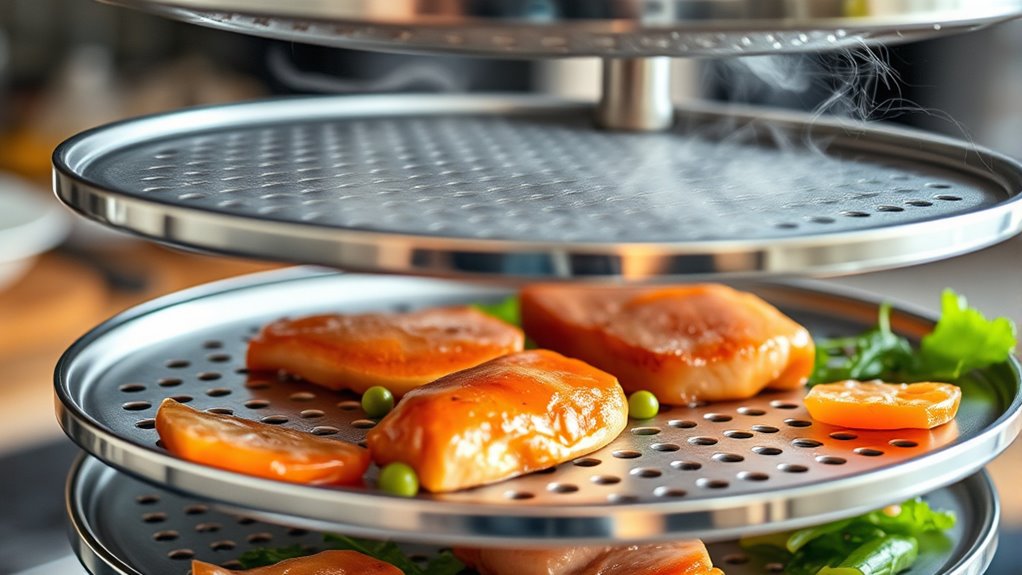
When steam is distributed evenly throughout a countertop steamer, it guarantees consistent cooking temperatures across all compartments, which helps prevent undercooked or overcooked areas. This precise distribution preserves food texture, moisture, and nutrients by reducing exposure to excessive heat or condensation. Directed steam ensures ingredients retain their original color, flavor, and nutritional value, especially for delicate items like seafood and vegetables. Efficient steam flow speeds up cooking times and improves uniformity, boosting overall efficiency. Models with stable steam supply and continuous circulation maintain ideal temperatures, reducing energy use and minimizing scale buildup. Proper steam distribution ultimately elevates both food quality and kitchen efficiency, and understanding how steam distribution works can help you select the best steamer for your needs. Incorporating proper maintenance practices also ensures optimal performance and longevity of your steamer, further enhancing its efficiency.
Frequently Asked Questions
How Does the Size of the Cooking Chamber Affect Steam Distribution?
The size of the cooking chamber directly affects how steam distributes inside it. In smaller chambers, steam reaches all areas quickly, ensuring uniform contact and consistent cooking. Larger chambers require well-designed circulation systems, like internal fans or diffusers, to prevent hot or cold spots. If the steam isn’t evenly spread, some parts may cook faster or slower, so you need proper design features to maintain even heat distribution across the entire chamber.
Can Steamers Be Customized for Specific Food Types or Recipes?
Yes, steamers can be customized for specific foods or recipes. You can adjust steam settings, fan speeds, and cooking cycles to match the needs of delicate seafood, vegetables, or buns. Some models even offer programmable options, so you set precise times and temperatures. This customization guarantees ideal texture, flavor, and presentation, making your kitchen more efficient and versatile while preserving food quality.
What Maintenance Is Required to Keep Steam Distribution Uniform?
To keep steam distribution uniform, you should follow a regular maintenance routine. Drain water daily to prevent residue buildup, wipe interior surfaces with a damp cloth, and flush steam lines with vinegar to clear mineral deposits. Weekly or monthly, remove and soak components like spray tubes and filters in vinegar, inspect gaskets and connections for wear, and clean the steam generator to prevent scale. Using softened water also helps maintain even steam flow.
How Do Different Lid Designs Influence Steam Circulation Within the Unit?
Your lid design directly impacts steam circulation inside your steamer. Lids with perforations or vents create turbulence, promoting even steam distribution. Solid lids with tight seals retain pressure, ensuring consistent flow, while multi-tier lids with separate vents prevent dead zones. Insulated or gasket-fitted lids help maintain temperature and pressure. By choosing the right lid, you optimize steam flow, leading to better, more uniform cooking results.
Are There Safety Features to Prevent Over-Pressurization in Countertop Steamers?
You’ll find safety features like pressure relief valves that automatically release excess pressure, preventing over-pressurization. Many models also include automatic shutoff systems that turn off the steamer if pressure gets too high. Digital controls help you monitor and adjust pressure precisely, while fail-safe devices keep everything secure. These features work together to guarantee safe operation, giving you peace of mind while cooking with your countertop steamer.
Conclusion
By understanding how steam distributes in your countertop food steamer, you can subtly influence the quality and efficiency of your cooking. When you pay attention to design features and operational controls, you’re gently guiding steam to work its magic evenly and swiftly. This silent partner in your kitchen helps you achieve delicious results with less effort, making every meal a delightful experience. Embrace these nuances, and your culinary creations will truly shine.
